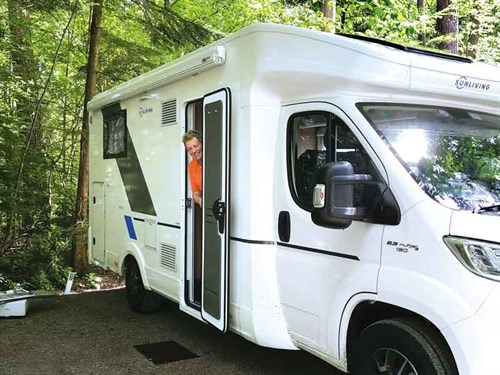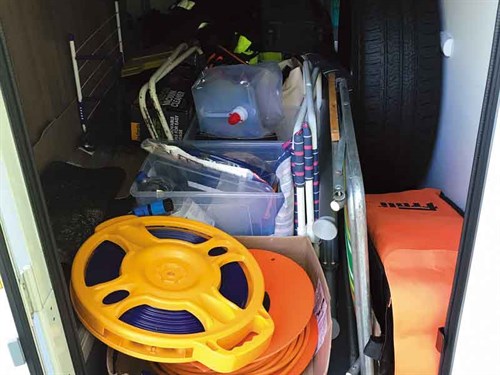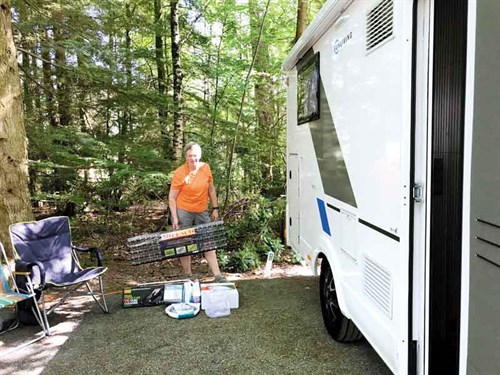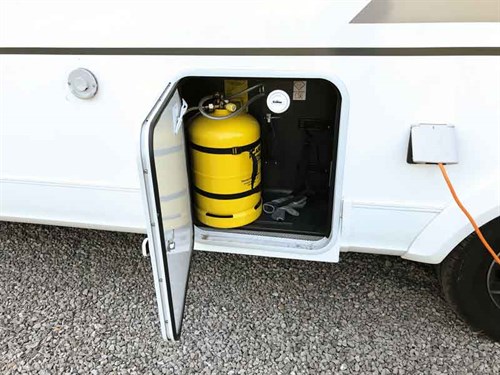Last month, we met Sue Elliott, who is buying a motorhome in the UK under the personal export scheme and planning to use the van in UK and Europe before shipping it back. In part one, she talked us through her research and the decision-making process that led her to buy a Sunliving from Adria.

This month, we catch up with Sue to learn what else she had to have in place before the big moment—picking up her RV.
So much to organise
I arrived in the UK a few weeks ahead of collecting the new motorhome. I’d arranged to house-sit so that I had a few weeks to organise the other essentials I needed ahead of the motorhome pick-up. This also meant I had a UK address I could use for things such as club membership cards and books. I wanted to know that once I took delivery, I was ready for the adventure to begin.

My arrival coincided with the Beast from the East storm earlier this year, and there was snow everywhere so I was glad I’d allowed ample preparation time.
Moving the money
Something I learnt early on was that paying for an RV is more complex when you need to move money between countries. Exchange rates can make quite a bit of difference to the final bill, so consider if you will get the best deal from your bank or a specialist money transfer service such as OFX.
Also, allow plenty of time for the money to reach the end point if there are any public holiday dates involved in either country. One payment I made took just over a week, as it straddled two holiday dates.
Hidden insurance costs
Insurance is expensive for a Kiwi wanting to drive a new motorhome in the UK/Europe for a year. I have a good driving and insurance record but because it’s not UK-based (for the last 20 years), the no-claims gets ignored and only a few companies will quote to cover a New Zealander.
The dealer reckoned a UK person (equivalent to me) would pay about £600 per year; I had to pay nearly £1900! I got quotes from two companies and they were very, very close. Budget for this and allow time to shop around. I tried to get quotes from many companies and it ate up a lot of time.
Many were unwilling to even start the process without the registration plate number, while others were willing to begin the process with just the VIN (Vehicle Identification No).
Insurers required me to have a UK address as a ‘home base’ address for the van. I was lucky that I could use a relative’s address, as I’ll base myself there at regular intervals during the trip and there is off-road parking for the motorhome. I also needed a UK address for the membership cards and equipment I was ordering.
As a side note, it pays to check if your new RV is fully covered for all breakdowns. The Fiat Assist scheme doesn’t cover things such as tyre changes/punctures, so I signed up for a separate breakdown service to make sure I didn’t need to worry about this.
Going clubbing
I joined both major touring clubs in the UK, downloaded a lot of site-finding apps, and also ordered the ACSI campsite book and card for Europe. It’s worth getting the paper books and not being totally app-dependent, as there have been times I have been unable to get online.
Both touring clubs offer motorhome manoeuvring courses for members. And since this was one of the things I was most worried about, I booked myself onto one.
Accessories and extras

The original deal on the motorhome included items such as spare wheel and holder, habitation door flyscreen, solar panel, awning, 4G WiFi, bike rack, rear-view camera, radio upgrade, and GPS. The dealer offered some additional accessories, and at this point, I chose an additional leisure battery and a gas system that can be refilled in situ at gas stations.
This means I don’t have to lift gas canisters and it will work anywhere in Europe where the gas canister systems vary between countries. I also opted for a starter-pack that included water hoses, toilet supplies, levelling ramps, and hook-up cables.
Stocking up

I am not a big shopper, but I decided to get on-board with online shopping, and before long I was regularly visiting Amazon and eBay.
There’s a lot you need:
- Bedding and towels
- Pans and cookware, crockery and cutlery, and utensils
- Drying racks
- Kettle
- Maps
- Toolkit, first-aid kit
- Water carrier, funnel
- Tyre grip mat, chocks
- Containers to keep things secure in cupboards
- Interior cleaning kit
Other things on my list (but less urgent), were outdoor chairs and table, a European travel kit, exterior van cleaning kit, BBQ, bike, and steps.

Key learnings
Plan ahead. It’s easier to order this stuff online than try to manoeuvre the van around the shops when you are still learning to drive it.
- Allow time for payments to make it through to the UK, especially if there are any New Zealand public holidays involved.
- Get a UK address ahead of time.
Next time
In Sue’s final instalment next month, she shares how her first few weeks using her new motorhome went.





